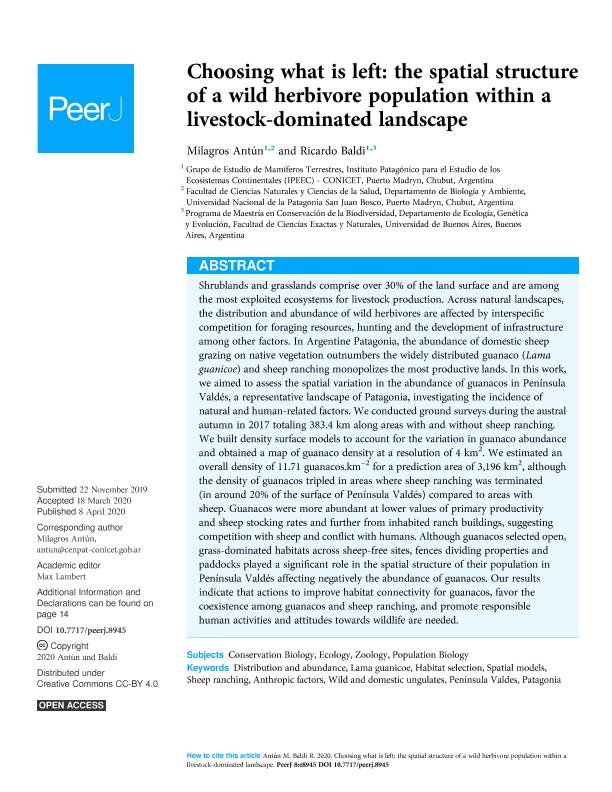Mostrar el registro sencillo del ítem
dc.contributor.author
Antun, Maria de Los Milagros

dc.contributor.author
Baldi, Ricardo

dc.date.available
2020-06-23T20:43:09Z
dc.date.issued
2020-04
dc.identifier.citation
Antun, Maria de Los Milagros; Baldi, Ricardo; Choosing what is left: the spatial structure of a wild herbivore population within a livestock-dominated landscape; PeerJ; PeerJ; 8; 4-2020; 1-20
dc.identifier.uri
http://hdl.handle.net/11336/108036
dc.description.abstract
Shrublands and grasslands comprise over 30% of the land surface and are among the most exploited ecosystems for livestock production. Across natural landscapes, the distribution and abundance of wild herbivores are affected by interspecific competition for foraging resources, hunting and the development of infrastructure among other factors. In Argentine Patagonia, the abundance of domestic sheep grazing on native vegetation outnumbers the widely distributed guanaco (Lama guanicoe) and sheep ranching monopolizes the most productive lands. In this work, we aimed to assess the spatial variation in the abundance of guanacos in Península Valdés, a representative landscape of Patagonia, investigating the incidence of natural and human-related factors. We conducted ground surveys during the austral autumn in 2017 totaling 383.4 km along areas with and without sheep ranching. We built density surface models to account for the variation in guanaco abundance and obtained a map of guanaco density at a resolution of 4 km2. We estimated an overall density of 11.71 guanacos.km−2 for a prediction area of 3,196 km2, although the density of guanacos tripled in areas where sheep ranching was terminated(in around 20% of the surface of Península Valdés) compared to areas withsheep. Guanacos were more abundant at lower values of primary productivityand sheep stocking rates and further from inhabited ranch buildings, suggesting competition with sheep and conflict with humans. Although guanacos selected open, grass-dominated habitats across sheep-free sites, fences dividing properties and paddocks played a significant role in the spatial structure of their population in Península Valdés affecting negatively the abundance of guanacos. Our results indicate that actions to improve habitat connectivity for guanacos, favor the coexistence among guanacos and sheep ranching, and promote responsiblehuman activities and attitudes towards wildlife are needed.
dc.format
application/pdf
dc.language.iso
eng
dc.publisher
PeerJ
dc.rights
info:eu-repo/semantics/openAccess
dc.rights.uri
https://creativecommons.org/licenses/by/2.5/ar/
dc.subject
DISTRIBUTION AND ABUNDANCE
dc.subject
LAMA GUANICOE
dc.subject
HABITAT SELECTION
dc.subject
SPATIAL MODELS
dc.subject
SHEEP RANCHING
dc.subject
ANTHROPIC FACTORS
dc.subject
WILD AND DOMESTIC UNGULATES
dc.subject
PENÍNSULA VALDÉS
dc.subject
PATAGONIA
dc.subject.classification
Ecología

dc.subject.classification
Ciencias Biológicas

dc.subject.classification
CIENCIAS NATURALES Y EXACTAS

dc.title
Choosing what is left: the spatial structure of a wild herbivore population within a livestock-dominated landscape
dc.type
info:eu-repo/semantics/article
dc.type
info:ar-repo/semantics/artículo
dc.type
info:eu-repo/semantics/publishedVersion
dc.date.updated
2020-06-19T18:19:14Z
dc.identifier.eissn
2167-8359
dc.journal.volume
8
dc.journal.pagination
1-20
dc.journal.pais
Estados Unidos

dc.description.fil
Fil: Antun, Maria de Los Milagros. Consejo Nacional de Investigaciones Científicas y Técnicas. Centro Científico Tecnológico Conicet - Centro Nacional Patagónico. Instituto Patagónico para el Estudio de los Ecosistemas Continentales; Argentina
dc.description.fil
Fil: Baldi, Ricardo. Consejo Nacional de Investigaciones Científicas y Técnicas. Centro Científico Tecnológico Conicet - Centro Nacional Patagónico. Instituto Patagónico para el Estudio de los Ecosistemas Continentales; Argentina
dc.journal.title
PeerJ
dc.relation.alternativeid
info:eu-repo/semantics/altIdentifier/url/https://peerj.com/articles/8945
dc.relation.alternativeid
info:eu-repo/semantics/altIdentifier/doi/http://dx.doi.org/10.7717/peerj.8945
Archivos asociados
